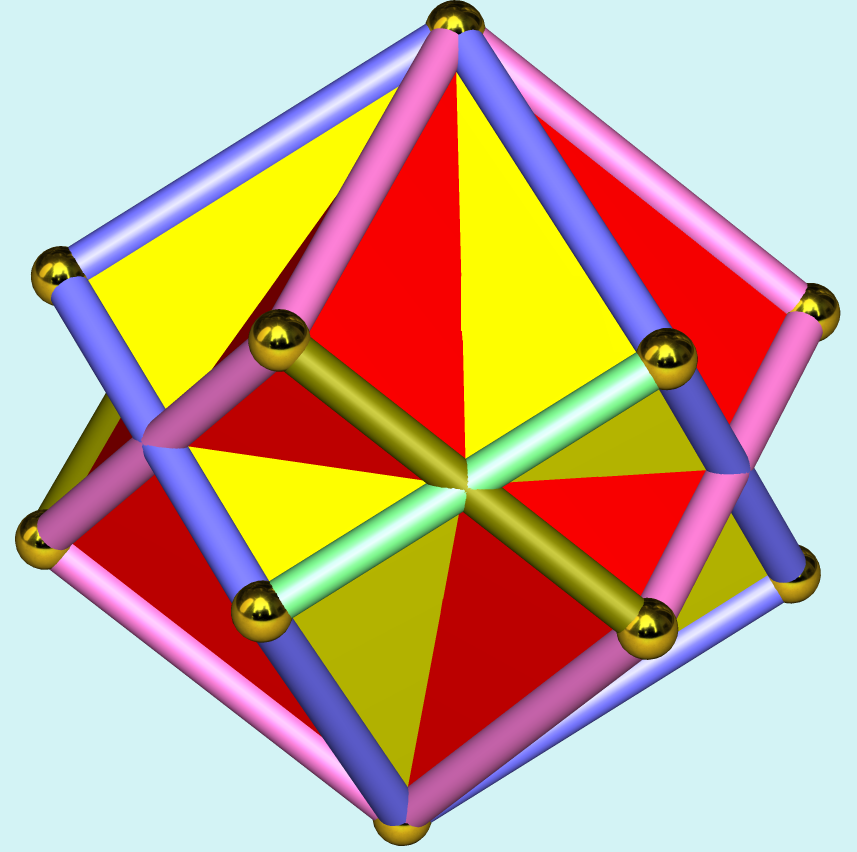|
Acronym
|
bitapna
|
|
Name
|
bitrigonal antiprismattic enenehexachoron,
compound of 8 ico in rico army,
compound of 2 kitapna
|
|
Coxeter symbol
|
2{3;4,3}[8{3,4,3}]
|
|
Circumradius
|
1
|
|
Vertex figure
|
 © ©
|
|
General of army
|
rico
|
|
Embedding
|
o3o
o3q o3q
q3o q3o
o3o q3q q3q o3o
Q3o
q3o o3Q o3Q q3o
q3q q3q
o3q Q3o Q3o o3q
o3Q
o3o q3q q3q o3o
o3q o3q
q3o q3o
o3o
|
hull = rico
(Q=2q)
|
o3o
o3o q3q q3q o3o
q3q q3q
o3o q3q q3q o3o
o3o
|
vertex-inscribed non-uniform 2 ico compound, infact
4 such components then build this uniform compound.
scaling factor = h = sqrt(3) = 1.732051
(vertex figure highlighted)
|
o3o
o3o q3o o3q o3o
o3q q3o
o3o q3o o3q o3o
o3o
|
single ico component
|
|
|
Confer
|
- blend-component:
-
ico
- compounds:
-
kitapna
|
This compound occurs in 6 different forms depending on whether the vertices (coincident by 2)
will be counted separately (type A), or will be identified while the incident edges will still be counted separately (type C),
or whether both would be identified (type E). All these would use 8 icositetrachora for compound components.
–
Each of those cases could be considered on base of the 4 icositetrachora compound (kitapna)
instead, i.e. using just 2 such components. That then gives rise to (type B) with no identifications, (type D) with identification
of vertices only, and (type F) with identifications of coincident vertices and concident edges.
How could this internal structure be understood?
–
Infact, there is a consistent 4-coloring of edges and faces for both, the oct and the ico:
Just color opposite faces of an oct alike and use for each edge the 3 other colors:
this then uses a chiral 3-ap coloring of the edges of oct.
Next, as there are 3 incident faces per edge in ico, this oct coloring extends into an alike
ico coloring also:
for each colored edge use as incident face colorings the various other colors.
Finally select one single of those colors and you'll have the special edges (which get doubled and thereafter identified in the compounding)
as well as the special faces (with no such special edge being used for its boundary) well-defined.
–
Those special faces of bitapna are being highlighted in the picture of the vertex figure in light blue and gold.
Incidence matrix
(Type A) - no identifications
192 ♦ 8 | 12 | 6 || 1 verf: cube
----+-----+-----+-----++--
2 | 768 | 3 | 3 || 1
----+-----+-----+-----++--
3 | 3 | 768 | 2 || 1
----+-----+-----+-----++--
6 | 12 | 8 | 192 || 1 oct
----+-----+-----+-----++--
24 | 96 | 96 | 24 || 8 ico
(Type B) - no identifications, but as 2 kitapna comp.
192 ♦ 8 | 12 | 6 || 1 verf: cube
----+-----+-----+-----++--
2 | 768 | 3 | 3 || 1
----+-----+-----+-----++--
3 | 3 | 768 | 2 || 1
----+-----+-----+-----++--
6 | 12 | 8 | 192 || 1 oct
----+-----+-----+-----++--
96 | 384 | 384 | 96 || 2 kitapna
(Type C) - identifying incident vertices only
96 | 16 | 24 | 12 || 2 verf: twirled vertex-first 2-cube comp. with no identifications
---+-----+-----+-----++--
2 | 768 | 3 | 3 || 1
---+-----+-----+-----++--
3 | 3 | 768 | 2 || 1
---+-----+-----+-----++--
6 | 12 | 8 | 192 || 1 oct
---+-----+-----+-----++--
24 | 96 | 96 | 24 || 8 ico
(Type D) - identifying incident vertices only, but as 2 kitapna comp.
96 | 16 | 24 | 12 || 2 verf: twirled vertex-first 2-cube comp. with no identifications
---+-----+-----+-----++--
2 | 768 | 3 | 3 || 1
---+-----+-----+-----++--
3 | 3 | 768 | 2 || 1
---+-----+-----+-----++--
6 | 12 | 8 | 192 || 1 oct
---+-----+-----+-----++--
96 | 384 | 384 | 96 || 2 kitapna
(Type E) - identifying vertices and coincident edges
96 | 2 12 | 18 6 | 12 || 2 verf: twirled vertex-first 2-cube comp. with identifications
---+--------+---------+-----++--
2 | 96 * | 6 0 | 6 || 2 edge-fig: 2-{3} comp.
2 | * 576 | 2 1 | 3 || 1
---+--------+---------+-----++--
3 | 1 2 | 576 * | 2 || 1
3 | 0 3 | * 192 | 2 || 1
---+--------+---------+-----++--
6 | 3 9 | 6 2 | 192 || 1 oct (as chiral 3-aps)
---+--------+---------+-----++--
24 | 24 72 | 72 24 | 24 || 8 ico
(Type F) - identifying vertices and coincident edges, but as 2 kitapna comp.
96 | 2 12 | 18 6 | 12 || 2 verf: twirled vertex-first 2-cube comp. with identifications
---+--------+---------+-----++--
2 | 96 * | 6 0 | 6 || 2 edge-fig: 2-{3} comp.
2 | * 576 | 2 1 | 3 || 1
---+--------+---------+-----++--
3 | 1 2 | 576 * | 2 || 1
3 | 0 3 | * 192 | 2 || 1
---+--------+---------+-----++--
6 | 3 9 | 6 2 | 192 || 1 oct (as chiral 3-aps)
---+--------+---------+-----++--
96 | 96 288 | 288 96 | 96 || 2 kitapna
©